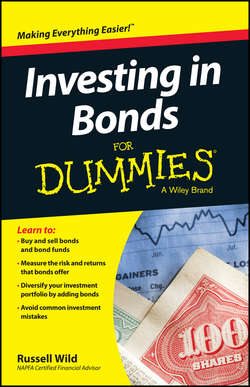Читать книгу Investing in Bonds For Dummies - Russell Wild - Страница 6
На сайте Литреса книга снята с продажи.
Part I
Bond Apetit!
Chapter 1
The Bond Fundamentals
Why Hold Bonds? (Hint: You’ll Likely Make Money!)
ОглавлениеIn the real world, plenty of people own plenty of bonds – but often the wrong bonds in the wrong amounts and for the wrong reasons. Some people have too many bonds, making their portfolios too conservative; some have too few bonds, making their stock-heavy portfolios too volatile. Some have taxable bonds where they should have tax-free bonds, and vice versa. Others are so far out on a limb with shaky bonds that they may as well be lending their money to Tommy Potts.
The first step in building a bond portfolio is to have clear investment objectives. ( “I want to make money” – something I hear from clients all the time – is not a clear investment objective!) Here are some of the typical reasons – both good and bad – why people buy and hold bonds.
Identifying the best reason to buy bonds: Diversification
Most people buy bonds because they perceive a need for steady income, and they think of bonds as the best way to get income without risking principal. This is one of the most common mistakes investors make: compartmentalization. They think of principal and interest as two separate and distinct money pools. They are not.
Let me explain: Joe Typical buys a bond for $1,000. At the end of six months, he collects an interest payment (income) of, say, $25. He spends the $25, figuring that his principal (the $1,000) is left intact to continue earning money. At the same time, Joe buys a stock for $1,000. At the end of six months, the price of his stock, and therefore the value of his investment, has grown to, say, $1,025. Does he spend the $25? No way. Joe reckons that spending any part of the $1,025 is spending principal and will reduce the amount of money he has left working for him.
In truth, whether Joe spends his “interest” or his “principal,” whether he spends his “income” or generates “cash flow” from the sale of stock, he is left with the very same $1,000 in his portfolio.
Thinking of bonds, or bond funds, as the best – or only – source of cash flow or income can be a mistake.
Bonds are a better source of steady income than stocks because bonds, in theory (and usually in practice), always pay interest; stocks may or may not pay dividends and may or may not appreciate in price. Bonds also may be a logical choice for people who may need a certain sum of money at a certain point in the future – such as college tuition or cash for a new home – and can’t risk a loss.
But unless you absolutely need a steady source of income, or a certain sum on a certain date, bonds may not be such a hot investment. Over the long haul, they tend to return much less than stocks. I revisit this issue, and talk much more about the differences between stocks and bonds, in Chapter 10.
For now, the point I wish to make is that the far better reason to own bonds, for most people, is to diversify a portfolio. Simply put, bonds tend to zig when stocks zag, and vice versa. The key to truly successful investing is to have at least several different asset classes – different investment animals with different characteristics – all of which can be expected to yield positive long-term returns, but that do not all move up and down together.
Going for the cash
Bonds are not very popular with the get-rich-quick crowd – for good reason. The only people who get rich off bonds are generally the insiders who trade huge amounts and can clip the little guy. Nonetheless, certain categories of bonds – high-yield corporate (junk) bonds, for example – have been known to produce impressive gains.
High-yield bonds may have a role – a limited one – in your portfolio, as I discuss in Chapter 3. But know up front that high-yield bonds do not offer the potential long-term returns of stocks, and neither do they offer the portfolio protection of investment-grade bonds. Rather than zigging when the stock market zags, many high-yield bonds zag right along with your stock portfolio. Be careful!
Some high-yield bonds are better than others – and they are held by relatively few people. I recommend those in Chapter 3.
Even high quality, investment-grade bonds are often purchased with the wrong intentions. Note: A U.S. Treasury bond, though generally thought to be the safest bond of all, will not guarantee your return of principal unless you hold it to maturity. If you buy a 20-year bond and you want to know for sure that you’re going to get your principal back, you had better plan to hold it for 20 years. If you sell it before it matures, you may lose a bundle. Bond prices, especially on long-term bonds – yes, even Uncle Sam’s bonds – can fluctuate greatly! I discuss the reasons for this fluctuation in Chapter 2.
I also discuss the very complicated and often misunderstood concept of bond returns. You may buy a 20-year U.S. Treasury bond yielding 3 percent, and you may hold it for 20 years, to full maturity. And yes, you’ll get your principal back, but you may actually earn far more or far less than 3 percent interest on your money! It’s complicated, but I explain this phenomenon in Chapter 2.
